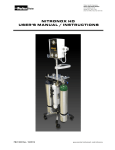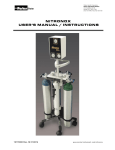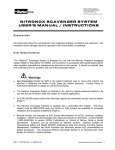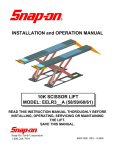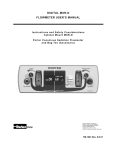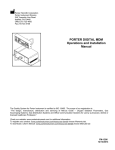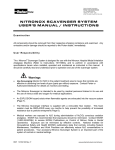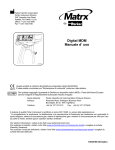Download NITRONOX USER'S MANUAL / INSTRUCTIONS
Transcript
NITRONOX USER’S MANUAL / INSTRUCTIONS 1 0 1 1 5 9 0 0 R e v. L 0 2 / 1 3 www.porterinstrument.com/nitronox Nitronox® Hospital Model Inhalation Analgesia Machine - Serial Number: Table of Contents Examination ............................................................................................................ 1 Warnings and Precautions ...................................................................................... 2 New or Modified Installations .................................................................................. 3 Self-Administration vs. Assist to Self-Administration .............................................. 3 Installations: Preparation of Mobile E-Stand ........................................................... 4 Installations: Preparation of Nitronox Scavenger Parts .......................................... 6 Installations: Attachment of Cylinders ..................................................................... 7 Description .............................................................................................................. 8 Functional Schematic .............................................................................................. 9 Specifications / Functional Features ....................................................................... 10 Functional Warnings and Cautions ......................................................................... 10 Functional Tests ...................................................................................................... 10 Operation / Maintenance......................................................................................... 11 Troubleshooting ...................................................................................................... 14 Warranty ................................................................................................................. 15 Examination Examine shipping carton for signs of external damage. Remove contents from carton and inspect for visible damage or missing parts. If damage is discovered or suspected and/or parts are missing, notify Porter or authorized distributor immediately. 1 IMPORTANT: READ MANUAL COMPLETELY BE F O R E O P E R A T I N G T H I S D E V I C E Basic delivery technique is described. Also, this manual contains instructions on periodically required checks to be performed by the user. These checks are necessary to insure the proper performance of this device and its safety features. Retain this manual for future reference. WARNINGS AND PRECAUTIONS These warnings and precautions are to help you to understand how to safely operate the Nitronox device. A WARNING alerts you to a possible hazard to people. A CAUTION alerts you to the possibility of equipment damage. low levels of ppm (parts per million) exposure. Contact Porter or Authorized Distributor for details on monitors and testing. Inspect and maintain the analgesia delivery system to prevent N2O leaks in all hoses, connections and fittings. Have all leaks repaired immediately. WARNING: New or modified installations properly connected gas pipelines are absolutely essential to patient safety. The ultimate responsibility of assuring that lines are not crossed rests with the user. See next page for details. WARNING: Medical workers are exposed to N2O during administration of N2O/O2 conscious sedation analgesia. NIOSH has recommended that exposures should be minimized. Contact NIOSH (1-800-35-NIOSH) to receive NIOSH Publications on Control of Nitrous Oxide in Dental Operatories. Exposure can be minimized by effective controls. National Institute for Occupational Safety and Health (NIOSH) publications state that controls, including System Maintenance, Ventilation and Work Practices can effectively reduce N2O concentrations in patient procedures. Your accessory Porter scavenger system is an important part of the system of controls in medical settings. WARNING: Porter Instrument equipment utilizes the cross+protection system. The flexible hose and connectors that connect to the housing are diameter indexed; 3/8” O.D. for Nitrous Oxide and ½” O.D. for Oxygen. The cross+protection system is designed to prevent misconnection of Oxygen and Nitrous Oxide hoses. DO NOT ATTEMPT TO CHANGE THE DIAMETERS OR CONNECTORS OF THE DEVICE! Tampering with the cross+protection system constitutes acceptance of liability by the installer. CAUTION: Always use clean, dry medical grade gases. Introduction of moisture or other contaminants into this device may result in defective operation. WARNING: Nitronox® Analgesia units are intended to be used by medical personnel trained in its use and the use of nitrous oxide and oxygen for medical applications. CAUTION: Do not attempt to repair, alter or calibrate this device. Unauthorized repair, alteration or misuse of this device is likely to adversely affect the performance and will void the warranty. WARNING: Do not use this device for the administration of general anesthesia or as a part of, or in conjunction with, a general anesthesia administration system. WARNING: Use Scavenging CAUTION: Never oil or grease any part of this system (minimize fire or explosion potential). Monitor for N2O in the patient treatment area to insure that controls are effective in achieving 2 WARNING: NEW OR MODIFIED INSTALLATIONS ALWAYS ASSURE THAT LINES ARE NOT CROSSED! WARNING: New or modified central supply installations - properly connected gas pipelines are absolutely essential to patient safety. The authorized distributor or contractor should provide written documentation that all gas pipelines are connected properly and that the system has been pressure tested prior to use. While this is a good business practice, it is important that the user verify by their own test, independent of the authorized distributor or contractor, that all gas pipelines are connected correctly prior to using the system. The ultimate responsibility of assuring that lines are not crossed rests with the user. Do not allow crossed lines to defeat the safety features of the Nitronox and/or central gas supply manifold systems. Crossed lines will create a dangerous and hazardous condition where, under a loss of oxygen supply, 100% nitrous oxide will be delivered through the oxygen delivery path and subsequently to the patient. Maintain patient observation during procedures. Prevent over sedation. If a patient becomes over sedated when being delivered 100% oxygen [during an apparent loss of nitrous oxide supply], it is a definite indication of crossed lines. If crossed lines are suspected, remove the mask immediately and encourage mouth breathing. Deliver pure oxygen from an oxygen demand valve only if the oxygen source is independent from the suspected crossed lines area. INPUT PRESSURE DIFFERENCES WARNING: Oxygen input pressure more than 15 psi higher than Nitrous Oxide input pressure will cause low oxygen percentage mixture delivery. DO NOT use Nitronox if O2 input exceeds N2O input by 15 psi or higher. SELF-ADMINISTRATION VS. ASSIST TO SELF-ADMINISTRATION WARNING: Encourage patient to self-administer. Self-administration is a safety feature of the demand flow Nitronox in that, if for any reason the patient becomes over sedated, the patient will be unable to successfully hold the mask in a tight seal position on the face. The result will be that the mask falls away from the face and the demand flow will cease, allowing the patient to breathe room air in through the mouth or nose. WARNING: If a patient is unable to fully self-administer, and the medical professional provides an assist to placement of the mask in a sealing position on the face, maintain patient observation to prevent over sedation under any conditions. Discontinue the assistance in mask placement immediately upon any observation of over sedation; remove the mask from the face entirely. Never use a mask strap to hold the mask to the face. Never force the mask on the face; the patient must always be spontaneously breathing. As an added precaution for procedures where an assist to self-administration is used, continuously sample the mixture delivery downstream from the demand valve by installation of an oxygen analyzer. 3 Section 1: Installations Nitronox Main Housing, Mobile E-Stand (Fig. 1.1), Mobile Stand, Wall Mount (Fig. 1.2), Demand Valve, Corrugated Hose, Scavenger Interface Preparation of Mobile E-Stand Fig. 1.1 Also see FM-916 E-Stand User’s Instructions 1. Slide Center Column with Cylinder Restraint and Cylinder Yoke Block into 5Star Base (Fig. 2.1). Push down firmly until snug. Align Cylinder Restraint as shown. Base of cylinders will fit in between wheels (Fig. 2.2). 4. Secure the Housing on the Mounting Post (Fig. 5.1) by twisting the Post (counterclockwise) with one hand and holding the Housing steady with the other hand. Twist until the Post is snug (Fig. 5.2). Fig. 1.1 Fig. 1.2 Fig. 2.1 Fig. 2.2 2. Adjust the Recessed Mounting Post to highest height by loosening and tightening the small black handle (Fig. 3.1) on the Yoke Block – and raising the Mounting Post (Fig. 3.2). E-Stand with Nitronox Fig. 3.1 Fig. 3.2 3. The Nitronox Main Housing will mount on the Mounting Post of the E-Stand [or Mobile Stand] by sitting the bottom of the Housing (Fig. 4.1) on top of the Mounting Post (larger threads Fig. 4.2). Hold the Mounting Post in one hand and position the Housing with the other. Wall Mount Fig. 5.1 Fig. 5.2 Fig. 4.1 Fig. 4.2 4 Preparation of Mobile E-Stand (continued) 5. Attach the Handle (Fig. 6.1) to the Mounting Post – just under the Retaining Ring / Oring (Fig. 6.2). Firmly tighten both screws so that the Handle cannot be twisted. The back of the Handle should be positioned over the back two cylinders (Fig. 6.3). 7. Connect the Diameter Indexed Safety System (DISS) green Oxygen and blue Nitrous Oxide Hoses to the appropriate connections (Fig. 8.1) on the bottom of the Nitronox Main Housing. Slide the Hoses through the opening in the Handle (Fig. 8.2) before connecting. Firmly tighten the Hoses using a wrench. Fig. 8.1 Fig. 6.1 Fig. 6.3 Fig. 8.2 Fig. 6.2 6. Carefully clip the [shipping accessory] plastic fasteners off of the green Oxygen Hose and blue Nitrous Oxide Hose – under the E-Stand Block (Fig. 7). Be careful – do not cut the Hoses. Fig. 7 5 Preparation of Nitronox Scavenger Parts For further details, refer to Nitronox Scavenger User’s Manual 10152100 8. Connect the Demand Valve (Fig. 9.1) to the black Gas Delivery Hose (connected through underside of Nitronox Main Housing Fig. 9.2). This is a quick connect attachment. Push the two ends together until click sound is heard (Fig. 9.3). To remove – push the metal clip in – and pull apart. 10. Follow instructions FM-1236 included with 19mm Magenta Hose: Part number 92120041 – 19mm Corrugated Scavenger Hose Assembly Instructions. (Figs. 11.1, 11.2, Fig. 12) Fig. 11.1 Fig. 11.2 Fig. 12 Fig. 9.1 Fig. 9.2 Fig. 9.3 9. The bracket and clip on the side of the Housing (Fig. 10.1) may be used to hold the Demand Valve assembly and Hoses when not in use (Fig. 10.2). Fig. 10.1 Nitronox Scavenger on Housing 11. Attach the Nitronox Scavenger Interface to the Center Column (Figs. 13.1, 13.2). Fig. 13.1 Fig. 10.2 6 Fig. 13.2 Attachment of Cylinders Caution: When operating the swivel yoke, take care not to catch or pinch fingers. 12. Loosen the Tee Handle (Fig. 14.1) until point is even with the inside of the Swivel Arm. Push Tee Handle inwards to flip to open position. Align Tee Handle vertically (Fig. 14.2). Fig. 16.4 O2 Pins Fig. 16.3 Warning Do not remove or alter gas indexing pins 16. Slide the cylinder into place by lining up the pins and pin holes on the cylinder. Push into place. Properly placed, the cylinder should hang on the pins (Fig. 17). Fig. 14.2 Fig. 14.1 13. Undo the Hook & Loop straps on the Cylinder Restraint (Fig. 15) 17. Cylinders should hang freely between wheel base. If the wheel base interferes, loosen and rotate cylinder restraint. 18. Rotate swivel clockwise to close (Fig. 18.1). Swivel will move into the locked position when Tee Handle is tightened. Secure the Hook & Loop straps to hold cylinder in place (Fig. 18.2). Fig. 15 14. Cylinder Preparation: Remove any plastic wrap from the top of cylinder, including the cylinder plastic washer. Verify that the rubber washer (Fig. 16.2) provided with the E-Stand is still in place. Use the E-Stand washer. Fig. 17 Fig. 18.1 15. Mount the “E” cylinders of Oxygen and Nitrous Oxide (not included) to the E-Stand Block. Insert cylinders correctly on indexing pins and as marked on Block (N2O Figs. 16.1, 16.2; O2 Figs. 16.3, 16.4). Pins assure mounting in appropriate position. Fig. 18.2 Fig. 19 19. The Cylinder Valve Wrench (hanging from black Knob) is used to open/close Cylinder Valves (Fig. 19). See FM-916 User’s Instructions. N2O Pins Fig. 16.1 Fig. 16.2 Rubber Washer 7 Section 2: Description of Unit Fig. 21 The Nitronox® Hospital Model is an inhalation analgesia apparatus designed to deliver a fixed concentration of 50% nitrous oxide and 50% oxygen on the demand flow principle. Nitronox operates either on pipeline gas supply using a Mobile Stand or Wall Mount, or medical “E” or “D” size cylinder supply by means of a small cylinder yoke block with regulators (Mobile “E” Stand). Fig. 20 - The Nitronox® Hospital Model is available in various configurations offering three mounting styles. 1. Nitronox Hospital with Mobile Stand only (for use with pipeline gas supply only). 2. Nitronox Hospital with Mobile “E” Stand (Fig. 20) and cylinder mount- (2) nitrous oxide and (2) oxygen – “E” or ”D” size. Refer to FM-916 for Installation and User Instructions. Fig. 20 3. Nitronox Hospital with wall mount (for use with pipeline gas supply) Use Nitronox Hospital Model in conjunction with Nitronox Scavenger System; Refer to User’s Manual / Instructions 10152100. Nitronox Hospital Model with Mobile “E” Stand Fig. 21 – Nitronox Front Cover with Mixture Pressure and N2O and O2 Line Pressure Gages 8 Nitronox ® Hospital Model Inhalation Analgesia Machine 9 Section 3: Specifications / Functional Features Gas Supply Duration “E” Size Cylinders At Normal Breathing Rates: N2O Approximately 6 – 6.5 Hrs. O2 Approximately 2 – 2.5 Hrs. Flow Capability 114 LPM, Maximum Oxygen Fail Safe: If apparatus oxygen line pressure is depleted or disconnected, nitrous oxide flow and demand valve flow stops automatically. If apparatus nitrous oxide line pressure is depleted or disconnected, demand valve will continue to function providing 100% oxygen at reduced flow capacity of about 55 LPM. If patient takes abnormal shallow breaths (100 to 200 cc tidal volume), oxygen concentration automatically increases. Mixture Concentration Mixture Concentration (Factory Adjusted) 50% N2O and 50% O2 +/- 5 Percentage Points O2 Warnings • If WHISTLE ALARM sounds, discontinue patient use immediately and shut off gas supply. • WARNING: DO NOT use Nitronox if O2 input exceeds N2O input by 15 psi or higher [see Warnings page 3] Mixer Pressure Alarm: A whistle will sound when a gas mixture regulator seat malfunction affecting mixture concentration has occurred. Warning: Nitronox® Analgesia units are intended to be used by medical personnel trained in its use and the use of nitrous oxide and oxygen for medical applications. Functional Tests Prior to first use and periodically thereafter (monthly is suggested), perform the following tests: Whistle Alarm Actuation: 1. Increase mixture pressure per Page 7, Step 2, “Maintenance”, until gauge reading is in RED “Do Not Use” area, per gauge illustration. Warnings • DO NOT use Nitronox if either line or mixture pressure is out of green band (see “Maintenance”). Figs. 22.1, 22.2 2. WHISTLE should sound in this range. 3. If WHISTLE sounds before or after this range, WHISTLE ALARM ACTUATOR must be adjusted (see “Maintenance”). Fail Safe Check-Out Test: Fig. 22.1 • Fig. 22.2 Encourage patient to self administer at all times [see Warnings page 3 for details]. 10 1. With unit in operation (one each O2&N2O gas supplies on), turn off or disconnect oxygen at supply source. 2. As oxygen pressure falls to zero (as read on oxygen line pressure gauge), demand valve flow must stop completely. Section 4: Operation / Maintenance Cylinder Pressure Readings: Oxygen is a true compressed gas, while in the cylinder, thus the cylinder pressure gauge can be used to determine the amount of gas remaining in the cylinder. For example, 2000 psi indicates full, 1000 psi indicates half full, etc. Nitrous Oxide is a liquefied compressed gas that vaporizes in the cylinder, thus the cylinder pressure gauge cannot be used to determine the amount of gas remaining in the cylinder until all liquid in the cylinder vaporizes. While liquid remains in the cylinder, the cylinder pressure gauge indicates the vapor pressure which depends on and varies with the temperature of the liquid. For example, at 68ºF, the vapor pressure is about 750 psi; at 20ºF, it drops to about 400 psi; while at 90ºF, it increases to about 1000 psi. After all the liquid vaporizes, the pressure will decrease normally as the gas is withdrawn, and the cylinder pressure gauge can then be used to determine the amount of gas remaining in the cylinder. 3. Minimize leak risks: With cylinder in position, rotate swivel arm and move into secure locked position when Tee Handle is tightened. To prevent movement and potential damage to yoke pins, always fasten the Hook & Loop strap restraints around cylinders. 4. Assure “E” Stand is populated with at least one full cylinder of O2 and N2O before starting any procedure. 5. Label each cylinder with a tag or sticker indicating “In-Use” and “Full” (“Full” is reserve cylinder.) 6. Use Cylinder Valve Wrench to open the “InUse” cylinders of O2 and N2O. Verify wrench is attached to Block. 7. Cylinder pressure gages on Block provide a visual indication of cylinder status (see details on Cylinder Pressure Readings) Cautions • Always turn on CYLINDER VALVES slowly and fully (“E” cylinder yoke models). • Hex hole in cylinder valve wrench to be used only to tighten cylinder valve packing nut in event of a leak. 8. Caution: If all four cylinders (or both cylinders of one gas) are open, the two cylinders of O2 and N2O will deplete in tandem. The “Full” cylinder will empty with the “In-Use” cylinder and will not be available as a future spare. • NEVER ATTEMPT TO LOOSEN cylinder valve packing nut. If valve stem is tight, return cylinder to supplier. 9. When “In-Use” cylinder is depleted, open the spare “Full” cylinder (Close valve on empty cylinder). Warning: Do not remove or alter gas indexing pins 10. When “In-Use” O2 cylinder is depleted, the Oxygen Fail Safe will stop N2O flow and demand valve flow automatically. Good practices: Cylinders with “E” Stand 1. Two cylinders of O2 and two cylinders of N2O are typically connected at all times. Exception: When using external gas supply of oxygen, the “E” Stand may be populated with N2O cylinders and O2 cylinders are not placed on “E” Stand. 2. Minimize leak risks: Confirm Yoke Washers are in place before replacing/mounting cylinders. Use Porter #A-3399-000 replacement washers (once/yr.). Have spare washers. 11 11. When “In-Use” N2O cylinder is depleted, the Nitronox will deliver 100% O2 through the Demand Valve. 12. After use, turn off cylinder valves. Caution: With O2 cylinder turned on, the Nitronox will have an intentional small O2 bleed, which will tend to deplete the O2 cylinder if, after use, the O2 cylinder valve is left on. Models With “E” Cylinder Yoke (Simple Operation Procedure) 1. Open one each O2 and N2O Cylinder Valves with wrench provided. 2. Observe cylinder pressures. Replace cylinder when less than 300 psi, at room temperature (21.1 ºC, 70ºF). During replacement, close all Cylinder Valves. Fig. 23.1 3. Observe line pressures (Fig. 23.1). Normal is 50-55 psi (green band) for static no-flow condition. Pressure will decrease slightly during each inspiration (see “Maintenance”). 4. Observe mixture pressure (Fig. 23.2). Normal is 30-35 psi (green band) for static no-flow condition. Pressure will decrease slightly during each inspiration (see “Maintenance”). 5. If all pressures are normal, Nitronox is ready to use. Remove Demand Valve with Mask from storage bracket. Instruct patient to hold Mask lightly on face covering nose and mouth. Instruct to breathe normally, preferably through nose. Encourage patient to self administer at all times [see Warnings page 3 for details]. 6. After use, turn off Cylinder Valves; store Demand Valve with Mask and Hose. Models Using Pipeline or External Gas Supply (Mobile Stand or Wall Mt.) 1. Connect external gas supply hoses to DISS (Diameter Indexed Safety System) fittings. External pressure must be 40-65 psi, preferably 50-55 psi. Observe external pressures on apparatus LINE PRESSURE GAUGES. WARNING: DO NOT use Nitronox if O2 input exceeds N2O input by 15 psi or higher. 2. Observe mixture pressure as in step 4 above. 3. Follow step 5 procedure above. 4. After use, disconnect external gas supply. 12 Fig. 23.2 Maintenance 1. Line Pressure Adjustment: (Green Band for Model Using Mobile “E” Stand): Locate appropriate PRESSURE REGULATOR (blue lettering – nitrous oxide; green lettering – oxygen); remove 9/16” acorn nut; insert 5/32” hex socket key and adjust pressure to within green band. 2. Mixture Pressure Control Adjustment: (Green Band): Remove LOWER CHROME PLUG from case back. With wrench, loosen 7/16 inch hex nut (counterclockwise) approximately one quarter turn. Insert screwdriver through access hole, in bottom of case, into slot of adjusting screw. While holding nut with wrench, adjust counterclockwise to increase pressure – clockwise to decrease. After adjustment, tighten nut while holding screw in position with screwdriver (see illustration Fig. 24). 3. Leak Test System – Monthly Check of working pressure leaks. Verify hoses are attached from E-Stand to Nitronox Housing. Turn one O2 and one N2O cylinder on. Verify EStand pressure gages read cylinder pressures. Verify Nitronox line pressure gages read within green band. Note: fail safe is open and pressure reaches Demand Valve. Turn off N2O cylinder valve. Verify that N2O E-Stand gage reads about 750 psi. Note exact needle position. Verify that there is little or no movement [up to ½ increment] of the exact needle position in 15 minutes. Nitronox N2O line pressure gage needle will stay in green band with no movement. Turn off O2 cylinder valve. It is normal that needle of O2 E-Stand gage will drop. Nitronox O2 line pressure gage needle will stay in green band with no movement (will eventually drop after E-Stand gage pressure naturally depletes). 13 4. Whistle Alarm Actuator Adjustment:Remove UPPER CHROME PLUG from case back. With mixture pressure temporarily adjusted in middle of range shown below (per Step 2, “Maintenance”), insert 1/8” hex key (not provided) into adjustment screw at end of ALARM ACTUATOR (see illustration Fig. 2). Adjust screw either clockwise or counterclockwise until whistle sounds clearly. DO NOT over adjust. Return mixture pressure to middle of green band. Whistle sound must stop with pressure in green band and whistle must sound with pressure in range shown below (about 40 psi). If this cannot be achieved, discontinue use of apparatus and notify authorized distributor immediately (see illustration Fig. 25). 5. Replacing the Check Valve See FM-916 “E” Stand for illustrations and instructions for replacement of the Check Valve Assembly. Fig. 24 Fig. 25 Section 5: Troubleshooting Field repair is limited to maintenance adjustments and replacement parts obtained through Porter. All other repairs should be performed by an authorized Porter service representative. PROBLEM POSSIBLE CAUSE CORRECTIVE ACTION 1. L e a k ag e a t YO K E C YLI ND ER VAL VE c o n n e ct i o n. Missing or defective yoke seal w a s her ( mo de l s w it h “ E” c y l i n d er y o ke) ; d am a ge d pin s . R e p la c e w i th P or t er p ar t N o . A - 33 9 9- 0 0 0 ( 4 p er U n i t) . 2. L o w or n o r ea d i n g o n C YLIND ER GAUG E w ith CYLINDER VALVES open. C y l i n de r pr e ss u r e t oo l ow o r c y l i n d er s emp t y ( mo d e l s w i t h “ E” cyl i nd er yo ke ). R e p la c e c y l in d er w i th f u l l c y l i n d er of ap p r o pr i at e g as . 3. O 2 c y l i nd er ( o r e x t er n a l s u p p l y) u se d t o o q u i c k l y O 2 c y l i nd er va l v e ( or e x t er n a l s u p p l y) l ef t on a ft er u se an d n a t ur a l b l ee d d e p le t e s c y l in d er ( or e x t er na l s u p p l y) . O 2 c y l i nd er co n t a in s up to 2 . 5 h r s. br ea t h ing su pp ly; N 2 O c y l i n d er c on ta i n s up to 6.5 hr s . A p p ar at u s e xp o s e d t o t e m per a tu r e b e l ow 32 º F / 0 º C . U s e pr a c t i c e o f tu r n i n g o ff c y l i n d er ( or ext e r n a l su p p ly ) a f t er u s e . 4. 5. 6. L i n e p r e s s ur e o ut of gr een b a n d. M ixt ur e pr e ssu r e s o ut of g r ee n b a nd . WHISTLE ALARM failure d u r in g f u n ct io n a l t e s t. 7 . WHISTLE ALARM sound N o te : a mo me n t ar y “ ch i r p” s o u n d i s a c ce p t ab l e u p on initial application of pressure if w h i s t le th e n s t o p s [ r e s e ats] E x p e c t h i g her u s a g e o f O 2 c y l i n d er s Allo w a p par at u s to r e tur n t o r o om t e mp era t ur e b e for e m a k i n g a d ju st m e nt . PRESSURE REGULATOR out o f ad j u stm e nt ( m od e l s w i th “ E” cylinder yoke) . S e e “ M a i n te na n c e” ad j u s tm e n t, Step 1. P R E S SURE REG UL AT O R d e f e ct i v e ( mo d e l s w i th “ E” cylinder yoke) . D i s c o nt i n ue u s e an d n o t ify a u t ho r i ze d d is t r i bu t or . CO NTRO LLED PR ESSURE REGULATOR section of m i x t ur e r e q u ir e s a d j u st men t S e e “ M a i n te na n c e” ad j u s tm e n t, Step 2. R EG U L AT O R m a l fu n c t io n ( mo d e l s w it h “ E” c y l i nd er yoke). A L A R M ACT U ATO R o ut of a d j u s tm e nt . D i s c o nt i n ue u s e an d n o t ify a u t ho r i ze d d is t r i bu t or . A C T U A T O R D EF EC T I V E L e a k a t N 2 O p r e s sur e co nt r o l s e a t ca u s i ng l o w O 2 c o n c e nt r a t i on . A C T U A T O R D EF EC T I V E. 14 S e e “ M a i n te na n c e” ad j u s tm e n t, Step 3. D i s c o nt i n ue u s e an d n o t ify a u t ho r i ze d d is t r i bu t or . D i s c o nt i n ue u s e an d n o t ify a u t ho r i ze d d is t r i bu t or . CERTIFICATE OF WARRANTY THIS WARRANTY IS GIVEN IN PLACE OF ALL OTHER WARRANTIES, EXPRESS OR IMPLIED, OF MERCHANTABILITY, FITNESS FOR A PARTICULAR PURPOSE OR OTHERWISE. Under no circumstances shall Parker Hannifin Corporation be liable for incidental or consequential damages as those terms are defined in the uniform commercial code. Parker Hannifin Corporation, Porter Instrument Division warrants that each product or part shall be free from defects in workmanship and materials, under normal use and with appropriate maintenance, for one (1) year from the date of delivery to customer unless otherwise specified in writing. All rubber and plastic parts and accessories are warranted under the same conditions for a period of ninety (90) days from date of purchase. No statement or claim about the product by any employee, agent, representative, or dealer of Parker Hannifin Corporation shall constitute a warranty by Parker Hannifin Corporation or give to rise to any liability or obligation of Parker Hannifin Corporation. Parker Hannifin Corporation shall not be liable for any damage, injury or loss arising out of the use of the product, whether as a result of a defect in the product or otherwise, if, prior to such damage, injury or loss, the product was (1) damaged or misused; (2) repaired, altered or modified by persons other than Parker Hannifin Corporation; (3) not installed in strict compliance with applicable codes and ordinances; or (4) not installed by an authorized Parker Hannifin Corporation dealer. Parker Hannifin Corporation's obligation for breach of this warranty, or for negligence or otherwise, shall be strictly and exclusively limited to the repair or replacement of the product or part. This warranty shall be void on any product on which the serial number has been altered, defaced or removed. ORDERS All orders are to be made through authorized Parker Hannifin Corporation distributors. All billing will be done through said distributors. Direct orders will be handled through the authorized local dealer as determined by Parker Hannifin Corporation. RETURNS All returned merchandise will be handled through the local Parker Hannifin Corporation distributor. No returns will be accepted unless authorized in writing by Parker Hannifin Corporation and accompanied by the original shipping invoice. All returns are subject to restocking charge. Policies subject to change without notice. T he Q ua lity Sys te m fo r Por ter Ins tr umen t is cer tified to ISO 134 85 . T he sco pe o f o ur r eg is tr a t io n is : Th e des ig n, m a nu fac tu r e , dis tr i bu t io n and s e r vic in g of N i tr ous O xid e - O xyg en Se da tion F low Me ters , Gas Sca veng ing Sys tems , Ste am Ster iliz ers , G as D is t r i bu t io n an d O f f ic e C omm un ica t io n S y s te ms fo r use b y a ph ys ici an , den t is t o r l ic e nsed h ea l thc a r e pr o fess io na l . 15

















